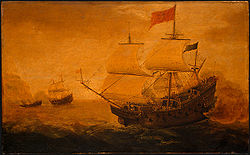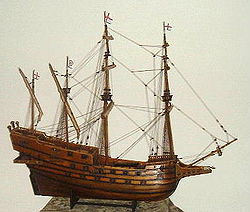Galleon
A galleon was a large, multi-decked sailing ship used primarily by European states from the 16th to 18th centuries. Whether used for war or commerce, they were generally armed with the demi-culverin type of cannon.
Contents
History
The galleon was an ocean going ship type which evolved from the carrack in the second half of the sixteenth century. A lowering of the forecastle and elongation of the hull gave galleons an unprecedented level of stability in the water, and reduced wind resistance at the front, leading to a faster, more maneuverable vessel. The galleon differed from the older types primarily by being longer, lower and narrower, with a square tuck stern instead of a round tuck, and by having a snout or head projecting forward from the bows below the level of the forecastle. In Portugal at least, carracks were usually very large ships for their time (often over 1000 tons), while galleons were mostly under 500 tons, although the Manila galleons were to reach up to 2000 tons. Carracks tended to be lightly armed and used for transporting cargo, while galleons were purpose-built warships, and were stronger, more heavily armed, and also cheaper to build (5 galleons could cost around the same as 3 carracks) and were therefore a much better investment for use as warships or transports. There are nationalist disputes about its origins and development, but each Atlantic sea power built types suited to their needs, while constantly learning from their rivals.
The galleon was powered entirely by sail, carried on three or four masts, with a lateen sail continuing to be used on the last (usually third and fourth) masts. They were used in both military and trade applications, most famously in the Spanish treasure fleet, and the Manila Galleons. In fact, galleons were so versatile that a single vessel may have been refitted for wartime and peacetime roles several times during its lifespan. The galleon was the prototype of all square rigged ships with three or more masts for over two and a half centuries, including the later full rigged ship.
The principal warships of the opposing English and Spanish fleets in the 1588 confrontation of the Spanish Armada were galleons, with the modified English "race built" galleons developed by John Hawkins proving decisive, while the capacious Spanish galleons, designed primaráily as transports for long ocean voyages, proved incredibly durable in the battles and in the great storms on the voyage home; most survived the ordeal.
Construction
Galleons were constructed from oak (for the keel), pine (for the masts) and various hardwoods for hull and decking. Hulls were usually carvel-built. The expenses involved in galleon construction were enormous. Hundreds of expert tradesmen (including carpenters, pitch-melters, blacksmiths, coopers, shipwrights, etc.) worked day and night for months before a galleon was seaworthy. To cover the expense, galleons were often funded by groups of wealthy businessmen who pooled resources for a new ship. Therefore, most galleons were originally consigned for trade, although those captured by rival states were usually put into military service.
The most common gun used aboard a galleon was the demi-culverin, although gun sizes up to demi-cannon were possible.
Because of the long periods often spent at sea and poor conditions on board, many of the crew sometimes perished during the voyage; therefore advanced rigging systems were developed so that the vessel could be sailed home by an active sailing crew a fraction of the size aboard at departure.
Distinguishing features
The most distinguishing features of the galleon include the long beak, the lateen-rigged mizzenmasts, and the square gallery at the stern off of the captain cabin. In larger galleons, a fourth mast was added, usually a lateen-rigged mizzen, called the bonaventure mizzen.
The galleon continued to be used into the 18th century, by which time purpose-built vessels such as the fluyt, the brig and the full rigged ship, both as a trading vessel and ship of the line, rendered it obsolete for trade and warfare respectively.
The oldest English drawings
The oldest known scale drawings in England are in a manuscript called "Fragments of Ancient Shipwrightry" made in about 1586 by Mathew Baker, a master-shipwright. This manuscript, held at the Pepysian Library, Magdalene College, Cambridge, provides an authentic reference for the size and shape of typical English galleons built during this period. Based on these plans, the Science Museum, London has built a 1:48 scale model ship that is an exemplar of galleons of this era.[1]
Notable galleons
- São João Baptista nicknamed Botafogo, the most powerful warship when launched (1534) by the Portuguese; became famous during the conquest of Tunis, where it was commanded by Infante Luís, Duke of Beja.
- Adler von Lübeck the largest ship of its day when launched in 1566.
- The Manila galleons, Spanish trading ships that sailed once or twice per year across the Pacific Ocean between Manila in the Philippines and Acapulco in New Spain (now Mexico); (1565 - 1815).
- San Salvador, flagship vessel in the João Rodrigues Cabrilho's 1542 exploration of present day California in the United States.
- Golden Hind, the ship in which Sir Francis Drake circumnavigated the globe 1577 -1580
- Ark Raleigh, the ship was designed and built by Sir Walter Raleigh. It was later chosen by Lord Howard, admiral of the fleet to be the flagship of the English fleet in the fight against the Spanish Armada in 1588 and was summarily renamed the Ark Royal.
- Revenge, a galleon built in 1577, the flagship of Sir Francis Drake in the Battle of the Spanish Armada in 1588, was captured by a Spanish fleet off Flores in the Azores in 1591 and sank while being sailed back to Spain.
- São Martinho, the Portuguese galleon, the flagship of Duke of Medina Sidonia, commander-in-chief of the Spanish Armada.
- Triumph, the largest Elizabethan galleon; flagship of Sir Martin Frobisher in the Battle of the Spanish Armada
- San Juan Bautista (originally called Date Maru, 伊達丸 in Japanese). She crossed the Pacific Ocean from Japan to New Spain in 1614. She was of the Spanish galleon type, known in Japan as Nanban-Sen (南蛮船).
- Nuestra Señora de la Concepción, a Spanish Galleon which was also nicknamed "Cacafuego" for its strong cannon. It was captured by Sir Francis Drake in 1578 and all its treasures were brought to England. It was holding treasures mined in one year by the Spanish in the Americas.
- Padre Eterno, a Portuguese galleon launched in 1663. It was considered to be the biggest ship of its time, carrying 144 pieces of artillery and able to carry up to 2.000t of cargo.
Notes
References
- Alertz, U. (1991) Vom Schiffbauhandwerk zur Schiffbautechnik : die Entwicklung neuer Entwurfs- und Konstruktionsmethoden im italienischen Galeerenbau (1400-1700), Hamburg : Kovač, ISBN 3-925630-56-2
- Humble, R. and Bergin, M. (1993) A 16th century galleon, Inside story series, Hemel Hempstead : Simon & Schuster, ISBN 0-7500-1339-7
- Kirsch, P. (1990) The Galleon: the great ships of the Armada era, London : Conway Maritime, ISBN 0-85177-546-2
- Rutland, J. (1988) A galleon, 2nd rev. ed., Connaty, M. (ed.), London : Kingfisher, ISBN 0-86272-327-2
- Serrano Mangas, F. (1992) Función y evolución del galeón en la carrera de Indias, Colección Mar y América 9, Madrid : Editorial MAPFRE, ISBN 84-7100-285-X
See also
External links
| |||||
bs:Galeon bg:Галеон ca:Galió cs:Galeona da:Galeon de:Galeone et:Galeoon el:Γαλιόνι es:Galeón eo:Galiono fr:Galion gl:Galeón hr:Galijun io:Galiono id:Galiung is:Galíon it:Galeone hu:Galleon nl:Galjoen (schip) ja:ガレオン船 lt:Galeonas no:Gallion nn:Gallion pl:Galeon pt:Galeão ro:Galion ru:Галеон sk:Galeóna sr:Галеон sh:Galeon fi:Kaljuuna sv:Galeon tr:Kalyon uk:Галіон zh:西班牙大帆船



